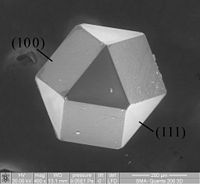
Photo from wikipedia
Abstract The corrosion inhibition action of three newly synthesized furanylnicotinamidine derivatives namely: 6-[5-{4(dimethylamino)phenyl}furan-2-yl]nicotinamidine (MA-1256), 6-[5-(4-chlorophenyl)furan-2-yl]nicotinamidine (MA-1266), and 6-[5-{4-(dimethylamino)phenyl}furan-2-yl]nicotinonitrile (MA-1250) on carbon steel (C-steel) was investigated in 1.0 mol⋅L−1 HCl solution by… Click to show full abstract
Abstract The corrosion inhibition action of three newly synthesized furanylnicotinamidine derivatives namely: 6-[5-{4(dimethylamino)phenyl}furan-2-yl]nicotinamidine (MA-1256), 6-[5-(4-chlorophenyl)furan-2-yl]nicotinamidine (MA-1266), and 6-[5-{4-(dimethylamino)phenyl}furan-2-yl]nicotinonitrile (MA-1250) on carbon steel (C-steel) was investigated in 1.0 mol⋅L−1 HCl solution by weight loss (WL), potentiodynamic polarization (PP), electrochemical impedance spectroscopy (EIS), and electrochemical frequency modulation (EFM) techniques. Morphological analysis was performed on the uninhibited and inhibited C-steel using atomic force microscope (AFM) and Infrared Spectroscopy (ATR-IR) methods. The effect of temperature was studied and discussed. Inspection of experimental results revealed that the inhibition efficiency (IE) increases with the incremental addition of inhibitors and with elevating the temperature of the acid media. The adsorption of furanylnicotinamidine derivatives on C-steel follows Temkin's isotherm. PP studies indicated that the investigated compounds act as mixed-type inhibitors and showed that p-dimethylaminophenyl furanylnicotinamidine derivative (MA-1256) was the most efficient inhibitor among the other studied derivatives with IE reached (95%) at 21 × 10−6 mol⋅L−1. MA-1266 is highly soluble in aqueous solution and has non-toxicity profile with LC50 > 37 mg·L−1. Thus, MA-1266 can be a promising green corrosion inhibitor candidate with IE > 91% at 21 × 10−6 mol⋅L−1. The experiments were coupled with computational chemical theories such as quantum chemical and molecular dynamic methods. The experimental results were in good agreement with the computational outputs.
Journal Title: Chinese Journal of Chemical Engineering
Year Published: 2020
Link to full text (if available)
Share on Social Media: Sign Up to like & get
recommendations!